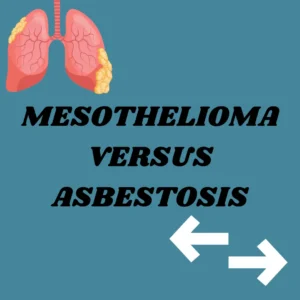Mesothelioma and Asbestosis: Asbestos-Related Diseases
Developing from asbestos exposure, mesothelioma and asbestosis are two lung diseases with unique characteristics. Although rare, mesothelioma is a highly aggressive form of cancer, whereas asbestosis is noncancerous, involving inflammation and scarring of the lung. The development timeframes of both asbestos-related diseases are distinct, with mesothelioma taking decades to develop, while asbestosis can take years. Regardless of the asbestos-related disease, it is crucial to seek medical help to monitor and attend regular checkups to monitor one’s health.

Mesothelioma
Mesothelioma often develops in the mesothelial tissue that lines various body cavities. It can manifest in different cellular types, such as epithelioid, sarcomatoid, or biphasic. The average life expectancy following a mesothelioma diagnosis is unfortunately short, ranging from 12 to 21 months. More than 3,000 new mesothelioma cases are diagnosed every year in the United States, emphasizing the need for early detection and awareness.
Asbestosis
Asbestosis, unlike mesothelioma, is not a cancer. However, it is a chronic respiratory condition characterized by the formation of scar tissue within the lungs and respiratory tract. Although there’s no cure, patients can survive for decades with proper treatment. In contrast to mesothelioma, the development of tumors or cancerous growths do not occur with asbestosis. Instead, it restricts lung function due to stiffening and thickening of lung tissues.
Shared Symptoms and Origin
Despite their differences, mesothelioma and asbestosis share symptoms, making diagnosis challenging without proper medical evaluation. Several of these symptoms include shortness of breath, chest tightness, persistent dry cough, weight loss, loss of appetite, and general fatigue. Although both diseases can lead to pleural effusion due to the accumulation of fluid in the pleura surrounding the lungs, mesothelioma patients often experience more severe symptoms earlier in the disease progression.
Development
Understanding the development of asbestos-related diseases is essential. The primary cause of these diseases is due to prolonged or repeated exposure to asbestos fibers. Asbestos fibers become trapped in the lungs and surrounding tissues when inhaled. The fibers trigger an inflammatory response by the immune system, leading to damage, scarring, and the eventual onset of asbestos-related conditions.
Diagnosing Mesothelioma and Asbestosis
Diagnosing both mesothelioma and asbestosis requires medical and occupational screening. Initial signs may appear on imaging, but neither disease exhibits distinct imaging findings until several years after asbestos exposure. A biopsy is necessary and important for differentiating between the two diseases. Various biopsy methods, such as bronchoscopy, needle biopsy, and thoracoscopic surgery, can provide critical information for accurate diagnosis.
Treatment
There are many treatment options available to patients when diagnosed with mesothelioma. Some of these treatments include surgery (procedures such as extrapleural pneumonectomy or pleurectomy and decortication), chemotherapy, and radiation therapy, depending on the stage and cell type. Asbestosis treatment primarily revolves around surgical procedures to drain excess fluid from the chest and lungs. Although in severe cases, a lung transplant may be an option.
In conclusion, despite the common origins between mesothelioma and asbestosis, there are varying characteristics, development timelines, and treatment approaches that are distinct between the two. Understanding these differences is essential for accurate diagnosis and appropriate medical care.
If you or a loved one has been diagnosed with mesothelioma or another asbestos-related disease, please call the Halpern Law Firm at (800) 505-6000 or fill out our form for legal help. Call today for a free case evaluation and to get more information. We have over 30 years of experience and have won over $100 million for our clients.
Sources:
https://medlineplus.gov/ency/article/000118.htm
https://www.lung.org/lung-health-diseases/lung-disease-lookup/asbestosis/symptoms-diagnosis
https://www.lung.org/lung-health-diseases/lung-disease-lookup/mesothelioma/symptoms-diagnosis
https://emedicine.medscape.com/article/295966-treatment
https://www.cancer.gov/types/mesothelioma/hp/mesothelioma-treatment-pdq
https://www.cancer.org/cancer/types/malignant-mesothelioma.html
https://www.sciencedirect.com/science/article/abs/pii/S0761842511002038

Written By Jeff Nelson
Don’t Wait—Contact an Experienced Pennsylvania Mesothelioma Attorney Today!
Now that you know the mesothelioma statute of limitations in Pennsylvania, contact an experienced attorney from our firm to represent your case before time runs out.
At Halpern Law Firm, we help clients throughout Pennsylvania, with offices in Philadelphia, Pittsburgh, Allentown, Scranton and Johnstown. Call us today for a free consultation at (800) 505-6000.